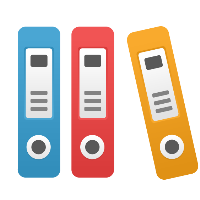Enterprise Objects and Folders
The iGrafx Platform allows you to create reusable objects in the repository that represent your enterprise's processes and activities, strategies, goals, performance indicators, risks, resources, and more. The data corresponding to these objects can then be correlated to show how these various objects support the work of the enterprise.
Your ability to view and modify repository content is determined by your access rights. See the Licenses vs Capabilities Matrix and Roles and Permissions topics for more information.
Enterprise objects that you can create include strategies, goals, and performance indicators that are useful in performance management methodologies, such as Balanced Scorecard. You can perform risk management tasks by identifying risks, and by placing business rules on processes. You can create and visualize RACI relationships.
Enterprise objects
The following topics describe the types of enterprise objects provided in the iGrafx Platform:
- Strategy, Goal objects are used to describe a long-term plan of action to achieve a particular goal. They serve to group related strategies, goals, and performance indicators.
- Requirement objects describe requirements for other, key repository objects, and can include business, financial, technical, and other kinds of requirements.
- Control and Control Instance objects serve as the controls placed around the activities of your enterprise—those actions required to ensure, or test (audit) for, compliance.
- Process, Activity objects represent the processes and activities involved in producing the products or services provided by your enterprise.
- Journey objects represent the touchpoints and moments of external and internal stakeholders in their customer journey.
- External Agent objects represent factors that are external to your enterprise, such as customers or vendors.
- Resource objects represent the resources required to perform processes, including organizational structure, functional roles, people, tools such as computer systems and physical equipment, physical locations, and information technology (IT) architecture.
- .Capability v17.6 objects represent the knowledge required to execute business or process activities, and if you need to acquire, keep or reduce efforts to maintain them.
- .Product v17.6 objects represent physical and non-physical products sold or processed.
- Business Service objects represent services available to external and internal parties, as well as indications of service levels.
- Interface, Service, and Operation Objects objects represent the interfaces, services, and operations offered by a resource, often a physical resource such as a computer system.
- Work Products represent physical objects or information that flow between External Agents, Processes, Resources, and Interfaces; for example, the order for a product.
- Dashboard objects represent pages presented in the iGrafx Dashboard area containing gadgets that visualize repository content in various ways.
- Report objects represent report definitions and narrative templates.
- Classes objects represent the programming classes used by your organization information technology (IT) staff to implement systems.
- Risk and Risk Instance objects are used to model risks inherent in a process, and can be applied to most enterprise objects.
- Opportunity and Opportunity Instance objects represent the potential positive effect of taking on a risk.
- Performance Indicator objects represent the "sensor" or measurement of or on any other business object.
Repository objects
The following topics describes the other types of repository objects provided in the iGrafx Platform:
- Diagram (web-authored) objects are diagrams created via the web in the iGrafx Platform.
- .Diagram and Sheet (client-authored) v17.6 objects can also be created and added to a repository with an iGrafx Client application (i.e. FlowCharter, Process, or Process for Six Sigma).
- .External File v17.6 objects represent non-iGrafx documents, e.g. PDF or Word files.
- Web Address objects represent URLs used to reference and open browser pages outside of the Platform.
- Chart objects provide graphic illustration of performance indicators.
- Table objects provide tabular view of performance indicators.
- Glossary objects represent the vocabulary of terms used in the organization, and often how abbreviations should be interpreted.
- Shape Library objects represent custom collections of graphics that can be used as shapes or artifacts in web-authored diagrams.
- Shortcut objects are links to other repository objects.
